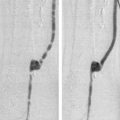Description
One-part, two-part, sheathed
One-part needles have a cutting bevel (think needles used for taking blood or injecting local anaesthetic). These are commonly used as a prelude to passage of a guidewire into a vessel. Two-part needles have an outer shaft and inner stylet, which extends up to or beyond the tip of the outer shaft. Sheathed needles feature a plastic outer sheath; this usually stays in place after the needle is removed (think intravenous cannula), the needle component may be one- or two-part.
Usually, one-part needles are used for simple access procedures, such as arterial puncture during angiography. Two-part systems are commonly used for deeper punctures, especially when using smaller-calibre needles.
Most needles have Luer lock hubs to allow attachment to a connecting tube. Some needles’ hubs have wings to aid manoeuvrability.
One-part needles have a sharp cutting bevel – do not swivel it side-to-side when looking for the vessel – you can tear the vessel wall.
Measurements
Puncture needles are usually described by their outer diameter, e.g. 21G (gauge)/18G. Sizing is counterintuitive, the larger the number, the smaller the needle. The 21G is the smallest in most IR departments. The inner diameter of a needle depends on the gauge and wall thickness but, in general, the higher the gauge the smaller the lumen and a 21G will only take a 0.018-inch wire.
Needles also vary in length. Generally, they have been getting longer as the population gets wider. It is certainly worth thinking about needle length, especially for deeper procedures, such as nephrostomy.




